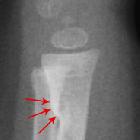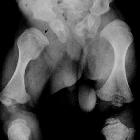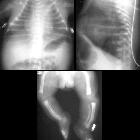Beinverbiegung bei Kindern

Röntgenbild
beider Beine bei Morbus Blount bei einem gut 1,5-jährigen Mädchen: Beidseits, links mehr als rechts, zeigt sich eine deutliche Varusdeformität mit Unregelmäßigkeit der Wachstumsfuge und Absenkung der Tibiametaphyse medial. Geringe Schrägstellung der Tibiametaphyse beidseits.


Identifier:
livinganatomypa00rotc (find matches)Title: Living anatomy and pathology;Year: 1910 (1910s)Authors: Rotch, Thomas MorganSubjects: Children Diagnosis, RadioscopicPublisher: Philadelphia London, J. B. Lippincott companyContributing Library: The Library of CongressDigitizing Sponsor: The Library of CongressView Book Page: Book ViewerAbout This Book: Catalog EntryView All Images: All Images From Book Click here to view book online to see this illustration in context in a browseable online version of this book.Text Appearing Before Image:Plate 84 PLATE 85.ADVANCED RHACHITIS. Boy, age 10 years. (Reduced 50%.) Great disturbance of the structure of the bones.Thickened cortex of concave sides of the tibiae. Pjlate 85Text Appearing After Image:PLATE 86.MARKED RHACHITIS. Boy, age 7 years. (Reduced 33£%.) Fig. 1.—Pelvis and Femora. The Roentgenograph shows especially the absorption of thelime salts in the upper epiphysis of the femur, with marked irreg-ularity in the structure of the bone, and a marked coxa vara.Note the greatly decreased density in the lower part of the fem-ora, the beak-shaped outline of the cavity of the pelvis, and thedeformed ilia with a great irregularity of the structure of the bone. A. Points to heavy deposit of cortical bone. The arrow points towards a foreign body, a needle whichwas accidentally found at the examination. Fig. 2. Photograph of the Same Subject. Shows a marked deformity from bowing of the legs. FIG. 1. Plate 86Note About Images Please note that these images are extracted from scanned page images that may have been digitally enhanced for readability - coloration and appearance of these illustrations may not perfectly resemble the original work.


Leg bowing in
children • Blount syndrome - Ganzer Fall bei Radiopaedia

Rickets •
Rickets - Ganzer Fall bei Radiopaedia

Leg bowing in
children • Fibular hemimelia - Ganzer Fall bei Radiopaedia

Rickets •
Rickets - Ganzer Fall bei Radiopaedia
Leg bowing in children is common and often developmental.
Differential diagnosis
The differential includes:
- developmental bowing
- exaggeration of normal age-related angulation changes at the knee
- neonates and infants normally have varus angulation that gradually corrects within 6 months of walking or by 2 years of age
- changes to valgus angulation at age 2-3 years and reverts to the adult pattern by age 6-7 years
- more common if begin walking at an early age, heavier children, and African-American children
- does not require treatment, but should follow-up to ensure resolution of bowing and ensure that tibia vara does not develop
- congenital bowing
- secondary to abnormal intrauterine position
- localized skeletal dysplasia or fetal vascular insufficiency may play a role in some cases
- usually bowing of tibia/fibula convex posteriorly and medially, less commonly convex laterally
- good prognosis for remodeling during growth, but bracing may be necessary in some cases
- associated leg-length discrepancy is usually seen
- secondary to abnormal intrauterine position
- rickets
- scurvy
- Blount disease
- tibia vara
- metaphyseal-diaphyseal angle >11° (in contrast to <8° in developmental bowing)
- usually unilateral or asymmetric (in contrast to symmetry of developmental bowing)
- focal fibrocartilaginous dysplasia
- neurofibromatosis type 1
- usually anterolateral bowing of the tibia with or without a hypoplastic fibula
- skeletal dysplasias
- osteogenesis imperfecta
- campomelic dysplasia
- hypoplasia of the fibula/fibular hemimelia
- achondroplasia
- hypophosphatasia
- Kniest dysplasia
- osteomyelitis
- syphilis: saber shin
- yaws: boomerang tibia
See also
Siehe auch:
- Osteomyelitis
- Osteogenesis imperfecta
- Morbus Paget des Knochens
- Grünholzfraktur
- Rachitis
- Neurofibromatose Typ 1
- Achondroplasie
- Biegungsbruch
- Skelettdysplasie
- inkomplette Frakturen im Kindesalter
- Morbus Blount
- Skorbut
- Tibia vara
- Hypophosphatasie
- camptomelic dysplasia
- Verbiegung der langen Röhrenknochen
- Kniest-Syndrom
- fetal limb bowing
und weiter:

 Assoziationen und Differentialdiagnosen zu Beinverbiegung bei Kindern:
Assoziationen und Differentialdiagnosen zu Beinverbiegung bei Kindern:














